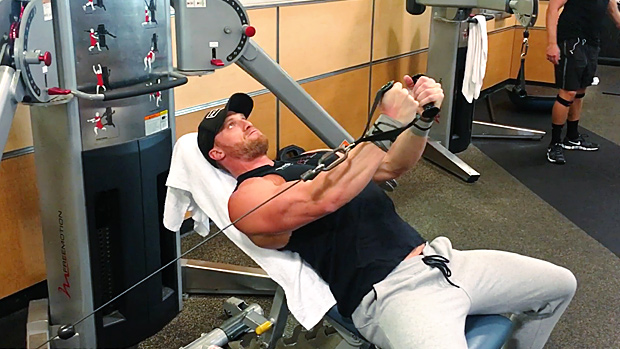Most bodybuilders have always used a split routine, training one or two body parts a day. Monday is chest day. Tuesday is legs day. Wednesday is for back and biceps. Thursday is for, I don't know, semitendinosus and rhomboids.
That's the way it's always been done, dammit. You don't question these things. It's like when you get dressed to leave the house. You're not an animal, so you put on a sock and a sock and a shoe and a shoe – not a sock and a shoe and a sock and a shoe.
That's the way the universe works. Every once in a while, though, some pudknockers come along and say we should do things differently. As far as body splits, a lot of coaches have been telling us to train whole body instead of doing split workouts. They insist it's more effective in adding muscle.
But is it? T Nation contributors and PhD types Brad Schoenfeld and Bret Contreras decided to put their doctoral muscle to work and conduct a study to see which workout scheme works better. (There were others involved in the study, but they don't contribute to T Nation, so I'm not naming them. Screw 'em.)
The scientists recruited 20 students, all of whom were experienced lifters, and split them into two groups of 10. The protocol for both groups consisted of 3 weekly workouts done on nonconsecutive days.
One group used a split-body routine (working two or three different body parts for each of 3 weekly workouts) while the other group did a whole-body routine (training all muscle groups on each of 3 weekly workouts).
Each lifter in each group did 2 to 3 sets per exercise for a total of 18 sets per session. Each set consisted of 8-12 reps done to concentric failure (while using a 2-second eccentric contraction). The load was adjusted for each exercise on successive sets to ensure the lifters could hit their target range. They were allowed 90 seconds of rest between sets.
Schoenfeld and his colleagues measured the subjects' pre- and post-study 1 repetition maximum strength in the bench press and squat. They also measured and tracked muscle thickness of the forearm flexors, forearm extensors, and vastus lateralis.
The study lasted 8 weeks. Here are the exact routines they performed for the split workout and the total body workout:
First Split Workout
- Bench Press: 3 sets
- Incline Press: 3 sets
- Hammer Chest Press: 3 sets
- Lat Pulldown: 3 sets
- Seated Row: 3 sets
Second Split Workout
- Squat: 3 sets
- Leg Press: 3 sets
- Leg Extension: 3 sets
- Stiff-Leg Deadlift: 3 sets
- Hamstrings Curl: 3 sets
- Good Morning: 3 sets
Third Split Workout
- Shoulder Press: 2 sets
- Hammer Shoulder Press: 2 sets
- Upright Row: 2 sets
- Hammer Curl: 2 sets
- Barbell Curl: 2 sets
- Preacher Curl: 2 sets
- Cable Pushdown: 2 sets
- Skull Crusher: 2 sets
- Dumbbell Overhead Extension: 2 sets
First Total Body Workout
- Squat: 3 sets
- Stiff-Leg Deadlift: 3 set
- Bench Press: 3 sets
- Lat Pulldown (wide grip): 3 sets
- Shoulder Press: 3 sets
- Hammer Curl: 2 sets
- Cable Pushdown: 2 sets
Second Total Body Workout
- Leg Press: 3 sets
- Hamstrings Curl: 3 sets
- Incline Press: 3 sets
- Lat Pulldown (close grip): 3 sets
- Hammer Shoulder Press: 2 sets
- Barbell Curl: 2 sets
- Skull Crusher: 2 sets
After 8 weeks, there wasn't any statistically significant change in the muscle thickness of the forearm extensors, but the effect size (the standardized mean difference between the two groups) was 96% greater in the total body group. The effect size for quadriceps thickness was also markedly greater in the whole body group.
No significant differences were found between pre- and post study strength, but Schoenfeld concluded that whole body routine was slightly better in putting on muscle:
"The findings suggest a potentially superior hypertrophic benefit to higher weekly resistance training frequencies."
Okay, the results weren't so definitive that anyone who does body split training is going to hold a pillow against their face and scream "Stoo-pid! Stoo-pid! Stoo-pid!" over and over again until they're spent, but it should at least make them consider doing total-body routines, especially since so many smart guys in the weightlifting business recommend it.
- Schoenfeld BJ et al. Influence of Resistance Training Frequency on Muscular Adaptations in Well-Trained Men. J Strength Cond Res. 2015 Jul;29(7):1821-9.





